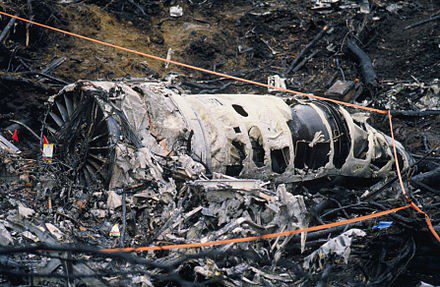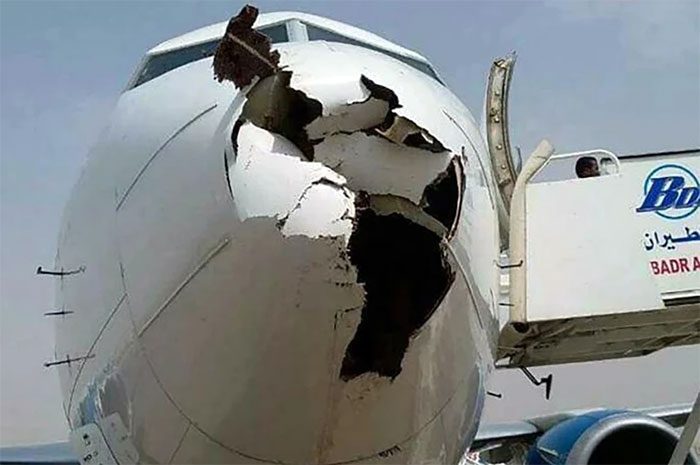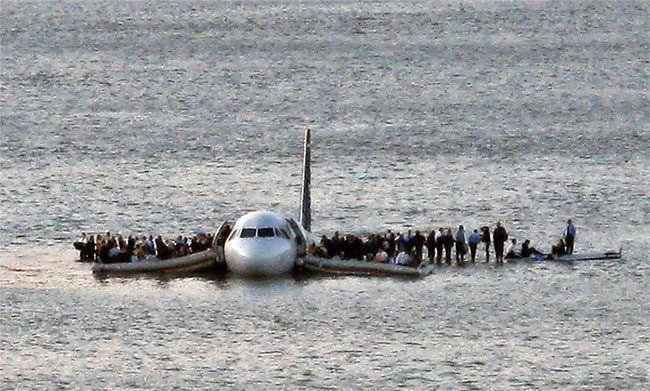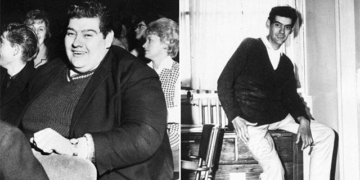Despite being heavy machines weighing several tons and made of ultra-durable materials, airplanes can encounter problems when facing tiny birds.
How can these fragile birds take down a giant metal bird?

Birds are prone to being sucked into engines when they collide with airplanes. (Photo: abcnews.com).
Plane Accidents Due to Bird Strikes
Most collisions occur when airplanes are close to the ground, particularly during takeoff or landing. A collision between birds and aircraft can turn into a serious accident if large birds from species such as geese, vultures, and gulls are sucked into the jet engine, causing blades to break and engine failure.

A Black Hawk helicopter was damaged after colliding with a crane. The Federal Aviation Administration (FAA) estimates that bird strikes cost the US around $400 million annually (including repair costs and losses from aircraft being unable to operate), resulting in over 200 deaths since 1988.
On January 20, 1995, a Dassault Falcon 20 crashed at an airport in Paris, France, while attempting an emergency landing. The incident was caused by a flock of small birds that flew into the aircraft’s engine, damaging it and causing a fire in the fuselage. All 10 people on board perished in the crash.

On September 22, 1995, a Boeing E-3 Sentry AWACS from the US Air Force, tail number 77-0354, crashed shortly after taking off from a base. Several geese flew into the engine, causing severe damage. The aircraft crashed approximately 3 kilometers from the runway, resulting in the deaths of all 24 people on board.
In April 2007, a Boeing 757 from Thomsonfly flying from Manchester Airport (UK) to Lanzarote Airport (Spain) experienced engine failure on its right side due to at least one bird strike. The engine caught fire and emitted heavy smoke. The plane had to return to Manchester for an emergency landing. Over 200 passengers on board experienced a heart-stopping moment, but fortunately, the aircraft landed safely. A bystander at the airport captured the entire incident.
On January 4, 2009, a Sikorsky S-76 helicopter collided with a red-tailed hawk while flying in Louisiana (USA). The hawk struck the helicopter’s windshield on the pilot’s right side. The impact shattered the glass, leading to a series of failures that caused the helicopter to lose power and crash into a swamp. Eight of the nine people on board died in the accident, and the remaining passenger sustained severe injuries.

Accidents caused by bird strikes often occur during takeoff or landing. (Photo: HA).
The New York accident on January 15, 2009, occurred just after a US Airways Airbus A320 took off from LaGuardia Airport with 155 passengers and crew on board. Reports indicate that the aircraft struck a flock of geese before landing on the river, and miraculously, no one was killed.
Danger from Speed Differences
Theoretically, large aircraft can continue flying after colliding with birds weighing up to 2 kg. However, there are 36 bird species in North America that average more than this weight, while even small birds like starlings can damage a powerful aircraft engine.
The greater the speed difference between the aircraft and the bird, the more frightening the impact on the airplane. The weight of the bird is also a factor, but the speed difference plays a bigger role. A flock of birds becomes more dangerous if they repeatedly strike the aircraft.
Dale Oderman, a professor of aerospace engineering at Purdue University (USA), states that birds pose a significant threat to aircraft, especially during takeoff. “Geese and larger bird species are more dangerous than small birds. When birds collide with an aircraft, they can be sucked into the engine and break the fan blades. The broken blade gets sucked deep into the engine and damages other components,” he says.

A Boeing 737 in Sudan suffered nose damage from a bird strike shortly after takeoff. (Photo: Aviation WG).
Hassan Shahidi, President and CEO of the Flight Safety Foundation, states, “Bird strikes pose a significant danger to aviation. This happens very frequently, not just with commercial aircraft but with all types of aircraft.”
Bird strikes typically occur when aircraft are close to the ground, meaning just before landing or shortly after takeoff—when jet engines are operating at maximum speed.
A collision can turn into a serious accident if birds such as geese, vultures, and gulls are sucked into the jet engine, causing fan blades to break and engine failure.
Although aircraft engines are protected by shields, a direct impact from a bird weighing over 2 kg can easily tear through this protective layer. Furthermore, birds striking the wings or landing gear can sometimes cause “false alarms,” leading pilots to mismanage the situation.
In agreement, Cao Van Thai, Deputy Head of Security and Safety at Airports Corporation of Vietnam (ACV), has shared that wild birds are very dangerous to aviation operations.
When colliding with an aircraft, birds can dent the fuselage, or in more severe cases, enter the control surfaces or engine, destroying equipment while the aircraft is moving at high speed, threatening safety.
The Larger the Bird, the More Dangerous the Plane Accident
According to CNBC, the greater the speed difference between the aircraft and the bird, the greater the force exerted on the aircraft. Collisions with flocks of birds are even more dangerous as they can lead to multiple chain reactions.
Last year, the FAA reported 17,200 incidents in the US or involving US carriers at airports abroad. This number is slightly lower than the reports from 2019 but is the highest in the past five years.
Despite the thousands of reported collisions, FAA data shows that reported damages account for only a small percentage. In 2022, there were 695 incidents that caused impacts, with only 36 resulting in significant damage. However, according to FAA reports, damage caused by wildlife to the aviation industry in the US was estimated to reach $328 million in 2021.

The famous 2009 accident when a plane from New York collided with birds and had to land on the river. The movie Sully, released in 2016, is based on this incident. (Photo: AP).
Flavio Mendonca, an assistant professor at Embry-Riddle Aeronautical University, states that bird-related accidents can occur at any time, as long as a bird collides with an aircraft—whether on the ground or in the air, hitting the wing, windshield, or other parts of the airplane. He notes that the most dangerous type of accident is when one or more birds fly into the aircraft’s engine.
“If a bird gets ‘caught’ in the engine, the damage to the aircraft can be severe,” Flavio Mendonca states. Although losing an engine does not cause the plane to fall immediately, the pilot must still return to the airport or find a safe place to land right away.
According to the Washington Post, the most infamous bird strike incident occurred when both engines of a US Airways aircraft failed after colliding with a flock of geese. Specifically, the incident occurred just after the aircraft took off from LaGuardia Airport in 2009. The incident caused both engines to fail, but all 155 passengers survived thanks to Captain Sully’s skillful landing in the Hudson River.
This incident, dubbed the “Miracle on the Hudson,” was famously adapted into a film released in 2016. Following the accident, the New York City government decided to implement several measures to reduce the number of birds around the airport.
NASA is also wary of Birds
During the launch of the Space Shuttle Discovery by NASA in July 2005, a vulture was spotted circling the launch pad. Weighing between 1.4 to 2.2 kg, the vulture could cause disaster if it struck the nose or wing of the shuttle during takeoff.
NASA has established several safety regulations since 2005 to minimize the risk of bird strikes during spacecraft launches. They do not want birds to hit the shuttle’s fuel tank during takeoff and landing, as such a collision could damage the thermal protection system. Therefore, during landing, NASA employs sonic devices to scare birds away from the runway.


















































